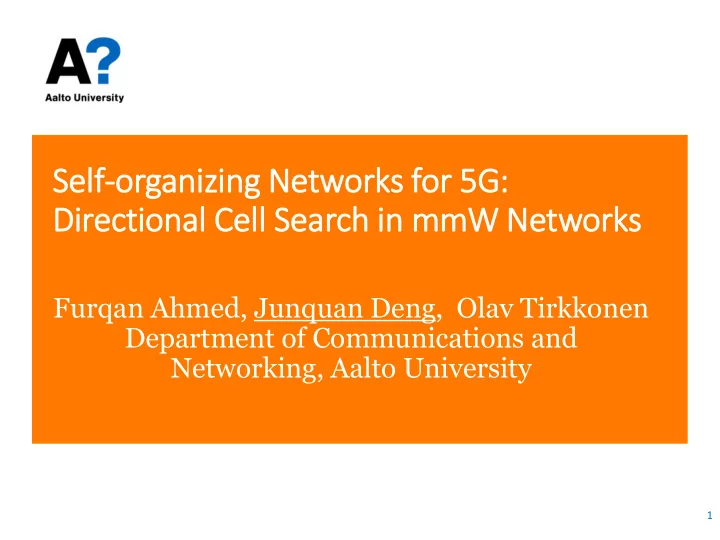

Self lf-organizing Networks for 5G: Dir irectional Cell Search in in mmW Networks Furqan Ahmed, Junquan Deng, Olav Tirkkonen Department of Communications and Networking, Aalto University 1
Overv rview • Road to 5G SON • Possible use-cases for 5G SON • SON based on graph models • Directional Cell Search(DCS) for mmW Networks • System model considered for DCS • Proposed framework for self-organized DCS • Beam assignment algorithm for DCS • Simulation results • Conclusion and Future Work 2
SON for 5G • Paradigms of 5G • Massive broadband • Massive M2M communication • Ultra-reliable communication • Disruptive Technologies for 5G • Massive MIMO 5G • millimeter wave (mmW) Requirements • Multi-RAT • SDN & C-RAN • SON for 5G • Potentials & Challenges 5G • User-centric Disruptive 5G SON • SDN-enabled Technologies 3
Road to to 5G SON: Use Cases • Spectrum Management and Sharing • Inter-operator spectrum sharing • Optimization of User Association • User association for mmW network • Multi-RAT Optimization • RAT-selection • Traffic steering • Inter-RAT handover • Directional Cell Search mmW • mmW beamforming for both data and control channel • Configuration of beams for efficient discovery 4
Road to to 5G SON : : Graph Models • The actual complicated network state can be abstracted and modeled as a network graph. • Nodes can be various physical and logical entities: such as TX/RXs, links, cells, sectors, beams etc. • Edges can be channel coefficients, interferences, various couplings. • Graph based models simplify the modeling and abstraction of networks, paving the way for efficient network-wide resource allocation and management. 5
Directional Cell Search : System Model • Network consisting of I base stations • Each cell has B analog beams for cell discovery • Time division multiplexing for beam broadcast • Handover margin (HOM) specifies handover users Analog beamforming for 8 × 8 planar array 6
Directional Cell Search : Agg ggregation of Measurements & & Control UE Base station Central Coordinator Handover measurement Distributed beam coloring Aggregate network graph Reporting Reporting Neighborhood graph Beam measurement Optimized beam coloring construction Color number selection Controlling Controlling Aggregation of handover Neighbor discovery Handover parameters measurement Beam set optimization for Color number selection discovery 7
Directional Cell Search : Graph Multicoloring Formulation • Consider Handover Relationships between Cells for History Users. • Let denote a multigraph representation of the network, A function related to interference is defined on the edge set . • Weighted Directed Multigraph : The graph is constructed on the basis of user measurements by considering interference-to-carrier (I/C) ratios between the strongest beam of potential handover candidate cell, and the beams in own-cell. 8
Directional Cell Search : Graph Multicoloring Formulation • A user receives multiple beams with varying powers from each base station. • There are potential handover candidate beams from neighbor cells • For each history handover user, there exists a single potential handover beam. • An I/C vector is calculated based on the interference a user receives from its own-cell beams and the received power from potential handover beam. 9
Directional Cell Search : Beam Assignment Algorithm 10
Directional Cell Search : : Simulation Setting
Directional Cell Search : : Simulation Setting
Directional Cell Search : : Simulation Results
Directional Cell Search : : Simulation Results • The setting of 16 colors with 16 directional single beams results in best handover discovery SINR performance. • Using less colors results in less overhead in neighbor cell search, but SINR performance will degrade and leads to an increased number of Radio Link Failures (RLFs). • One iteration is almost optimal by local update of color patterns for each cell.
Future Work • Extending the proposed self-organization framework to model other relevant aspects of 5G SON, most notably energy efficiency. • Joint self-optimization of multiple parameters such as beam direction and transmission power.
Recommend
More recommend